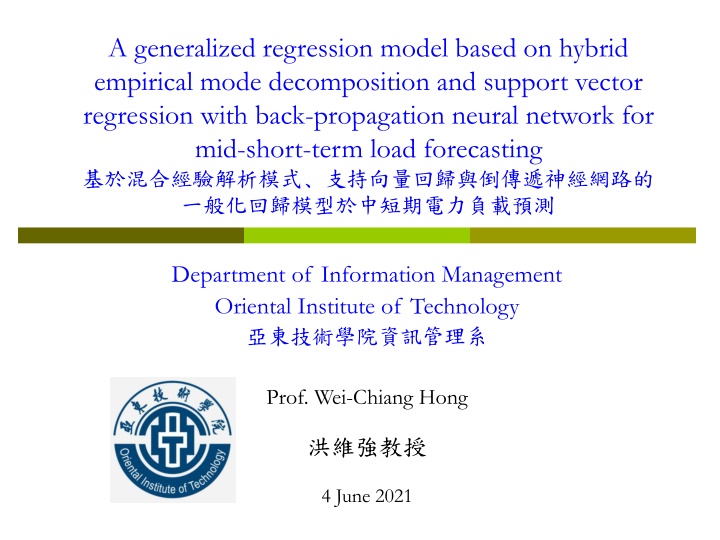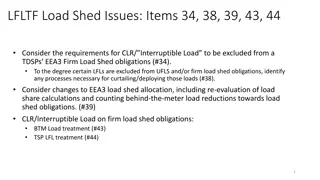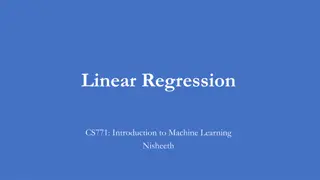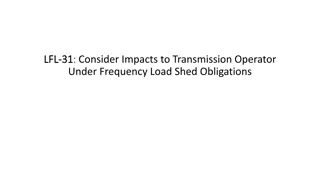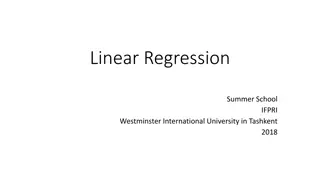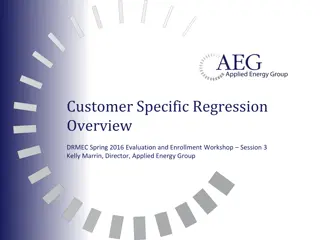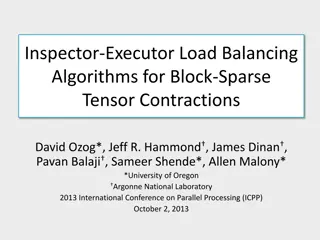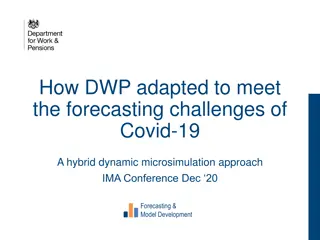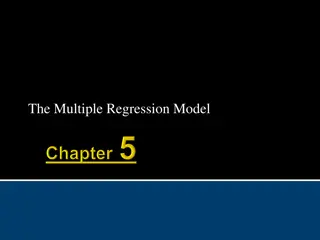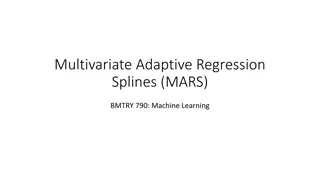Hybrid Regression Model for Load Forecasting
A hybrid regression model based on hybrid empirical mode decomposition and support vector regression with back-propagation neural network is proposed for mid-short-term load forecasting. The model aims to accurately predict electric load data within a few months or weeks by considering nonlinearity and various external factors. Traditional methodologies are compared with artificial intelligent technology like artificial neural networks and support vector machines to improve forecasting accuracy and address complex nonlinear relationships in data.
Download Presentation

Please find below an Image/Link to download the presentation.
The content on the website is provided AS IS for your information and personal use only. It may not be sold, licensed, or shared on other websites without obtaining consent from the author.If you encounter any issues during the download, it is possible that the publisher has removed the file from their server.
You are allowed to download the files provided on this website for personal or commercial use, subject to the condition that they are used lawfully. All files are the property of their respective owners.
The content on the website is provided AS IS for your information and personal use only. It may not be sold, licensed, or shared on other websites without obtaining consent from the author.
E N D
Presentation Transcript
A generalized regression model based on hybrid empirical mode decomposition and support vector regression with back-propagation neural network for mid-short-term load forecasting Department of Information Management Oriental Institute of Technology Prof. Wei-Chiang Hong 4 June 2021
hybrid EMD and SVR with BPNN for mid-short-term load forecasting Publication certificate A generalized regression model based on hybrid empirical mode decomposition and support vector regression with back-propagation neural network for mid-short-term load forecasting Authors: Fan, G.-F., Guo, Y.-H., Zheng, J.-M., and Hong, Wei-Chiang* Journal of Forecasting, 39(5) Pages 737-756, August 2020 DOI:10.1002/for.2655 2025/3/12 Wei-Chiang Hong Page 2
hybrid EMD and SVR with BPNN for mid-short-term load forecasting Outline Mid-short term load forecasting The role of artificial intelligent technology in forecasting The proposed hybrid model (hybridizing AI with traditional models) Results and Comparisons Conclusions Q & A 2025/3/12 Wei-Chiang Hong Page 3
hybrid EMD and SVR with BPNN for mid-short-term load forecasting Mid-short term electric load forecasting Mid-short-term load refers to electric load data within a few months or weeks, mainly including monthly data. As mentioned in reference, accurate electric load forecasting is conducive to rationally arranging power grid operation modes, and, unit maintenance plans, to reduce the economic costs of operators in the electricity market, i.e., ensure the competitiveness of operators. However, electric load data nonlinearity, they are affected by many external factors, such as climatic conditions, production activities, promotion activities, energy policy, date types, and number of users. often fluctuate and exhibit 2025/3/12 Wei-Chiang Hong Page 4
hybrid EMD and SVR with BPNN for mid-short-term load forecasting The role of artificial intelligent (AI) technology in forecasting Traditional methodologies of electric load forecasting include time series methods: autoregressive integrated moving average (ARIMA), exponential smoothing models, regression models, and Kalman filter models. The theoretical developments of these traditional methods are mature, but it can be difficult to find the optimal solution when dealing with large amounts of data and complex nonlinear relationships between data. AI-based forecasting models, such as artificial neural networks (ANNs), support vector machine (SVM), and fuzzy inference method, overcome the shortcomings of traditional forecasting models and can conduct nonlinear mapping relationships among variables to obtain the optimal solution of the forecasting models. 2025/3/12 Wei-Chiang Hong Page 5
hybrid EMD and SVR with BPNN for mid-short-term load forecasting The proposed hybrid model (hybridizing AI with traditional models) Recently, many novel electric load forecasting models have been proposed to achieve more accurate performance, such as hybrid model. This paper proposes a hybrid model by hybridizing empirical model decomposition (EMD) method with support vector regression (SVR) and back-propagation neural network (BPNN) to improve the performance of electric load forecasting. empirical model decomposition (EMD) method stands as a pre-processing tool to decompose the time series into several sub-sequences with simple (singular) tendency. put each decomposed sub-sequences into SVR and BPNN to separately obtain forecasting values. add these forecasted values to receive the final forecasting values. 2025/3/12 Wei-Chiang Hong Page 6
hybrid EMD and SVR with BPNN for mid-short-term load forecasting Flowchart of the proposed model 2021/6/4 Wei-Chiang Hong Page 7
hybrid EMD and SVR with BPNN for mid-short-term load forecasting Those used methods (for more details please refer published paper) EMD Step 1. Recognize. Recognize all maxima and minima of the data set x(t). Step 2. Mean envelopes. Use two cubic spline functions to connect all maxima and minima of the data set x(t), to fit the upper envelope and lower envelope, respectively. Then, calculate the mean envelope, m1, by taking the average value of the upper envelope and the lower envelope. Step 3. Decomposing. Produce the first IMF candidate, c1, by taking the data set x(t) subtract m1, as illustrated in Equation (1): Step 4. IMF Identify Step 5. IMF composition 2025/3/12 Wei-Chiang Hong Page 8
hybrid EMD and SVR with BPNN for mid-short-term load forecasting Those used methods (for more details please refer published paper) SVR By quadratic optimization, the original SVR regression function can be estimated as Then, Gaussian kernel function can be used to replace K(xi,x) The established SVR model can be used to forecasting. 2025/3/12 Wei-Chiang Hong Page 9
hybrid EMD and SVR with BPNN for mid-short-term load forecasting Those used methods (for more details please refer published paper) BPNN 2025/3/12 Wei-Chiang Hong Page 10
hybrid EMD and SVR with BPNN for mid-short-term load forecasting Results and Comparisons (1/6) Data set: 365 daily electrical load data (from 8:00 a.m. on January 1, 2007, to 0:00 a.m. on January 1, 2008. This analysis is divided into two parts: the first half of the year and the second half of the year, forecasting the electric load for the last month of each part (i.e., June and December). Electric load data decomposed by EMD 2025/3/12 Wei-Chiang Hong Page 11
hybrid EMD and SVR with BPNN for mid-short-term load forecasting Results and Comparisons (2/6) Forecasting errors 2025/3/12 Wei-Chiang Hong Page 12
hybrid EMD and SVR with BPNN for mid-short-term load forecasting Results and Comparisons (3/6) Compare with other benchmarking models 2025/3/12 Wei-Chiang Hong Page 13
hybrid EMD and SVR with BPNN for mid-short-term load forecasting Results and Comparisons (4/6) Significance test 2025/3/12 Wei-Chiang Hong Page 14
hybrid EMD and SVR with BPNN for mid-short-term load forecasting Results and Comparisons (5/6) Special data points comparison The forecasting results of the proposed EMDHR-SVR-BPNN model are relatively superior in weeks 1, 2, 3, and 4. 2025/3/12 Wei-Chiang Hong Page 15
hybrid EMD and SVR with BPNN for mid-short-term load forecasting Results and Comparisons (6/6) Special data points comparison The forecasting results of the proposed EMDHR-SVRBPNN model are superior in the whole of December. 2025/3/12 Wei-Chiang Hong Page 16
hybrid EMD and SVR with BPNN for mid-short-term load forecasting Conclusions This paper proposes the EMDHR-SVRBPNN by hybridizing EMD method, SVR model, BPNN model, and the generalized regression model to enhance the forecasting accuracy. The forecasting accuracy of the proposed EMDHR-SVR-BPNN model are superior to the other three compared models (ARMA, SVR, and BPNN), it can adapt to the development needs of modern smart grids and intelligent control systems. The proposed EMDHR-SVR-BPNN model can be widely applied in mid-short-term load production decision making. 2025/3/12 Wei-Chiang Hong Page 17
hybrid EMD and SVR with BPNN for mid-short-term load forecasting Q & A Thanks for your patient listening. I m glad to discuss any related question with you. If you have any advanced suggestion or problem, please do not hesitate to contact with me via e-mail. E-mail: samuelsonhong@gmail.com A generalized regression model based on hybrid empirical mode decomposition and support vector regression with back-propagation neural network for mid-short-term load forecasting Authors: Fan, G.-F., Guo, Y.-H., Zheng, J.-M., and Hong, Wei-Chiang* Journal of Forecasting, 39(5) Pages 737-756, August 2020 DOI:10.1002/for.2655 2025/3/12 Wei-Chiang Hong Page 18
hybrid EMD and SVR with BPNN for mid-short-term load forecasting 2025/3/12 Wei-Chiang Hong Page 19
